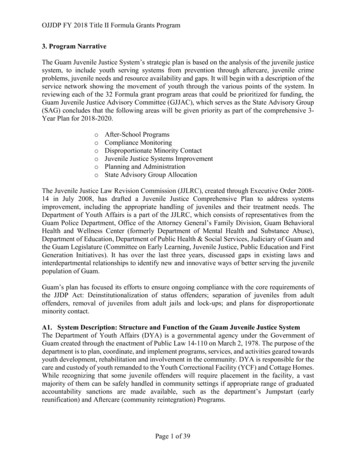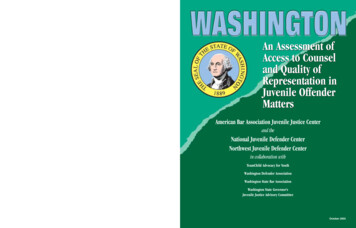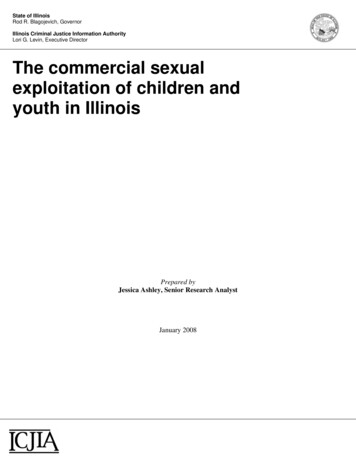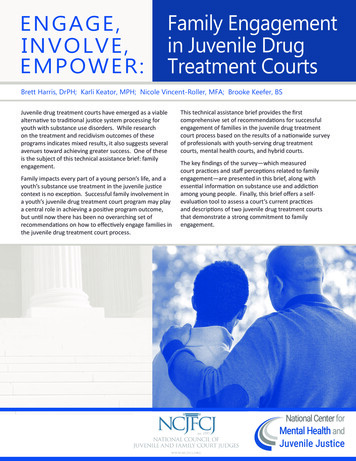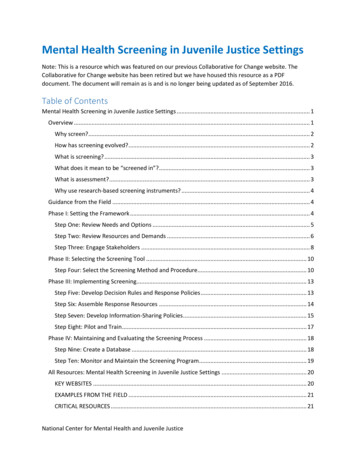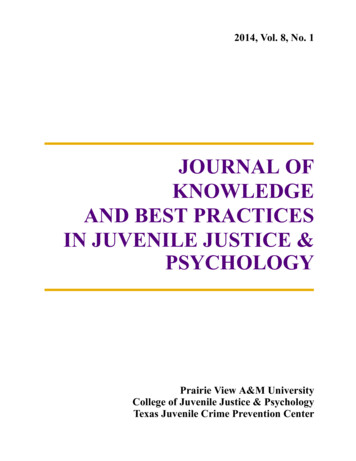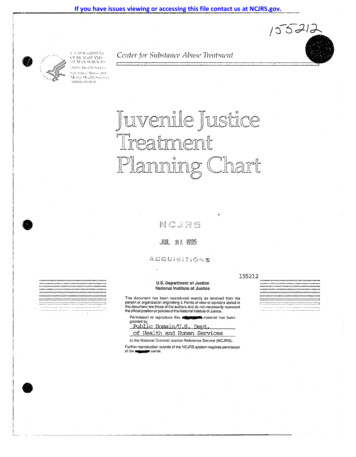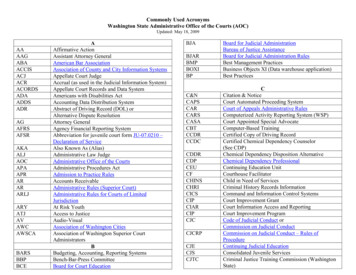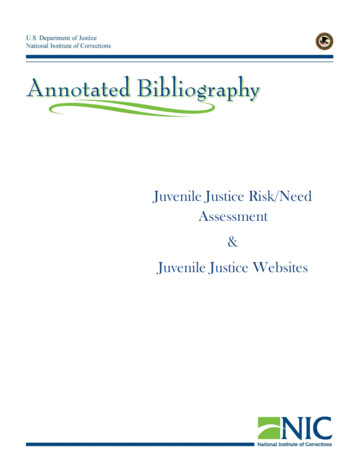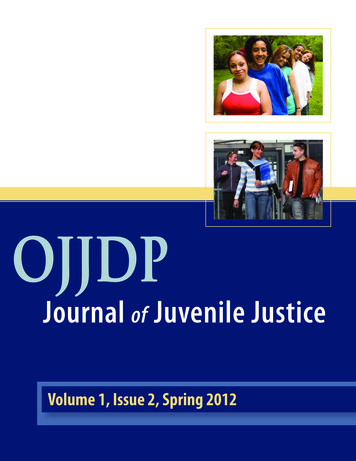
Transcription
OJJDPJournal of Juvenile JusticeVolume 1, Issue 2, Spring 2012
Editor in Chief:Monica L.P. Robbers, Ph.D.mrobbers@csrincorporated.com; mrobbers@marymount.eduAssociate Editor:Eve ShapiroEveShapiro@aol.comDeputy Editors and e-publishing: Kimberly TaylorStephen ConstantinidesAdvisory Board:Janet ChianconeCatherine DoyleBrecht DonoghueEditorial Office:CSR Incorporated2107 Wilson Blvd, Suite 1000Arlington, VA 22201Phone: 703-312-5220Fax: 703-312-5230Journal website:www.journalofjuvjustice.orgISSN: 2153-8026Peer ReviewersProf. Billie GasticRelay Graduate School ofEducationNew York, New YorkMs. Rena KreimerUniversity of PennsylvaniaSocial Policy & PracticePhiladelphia, PennsylvaniaDr. R. Anna HaywardSUNY Stony BrookSchool of Social WelfareStony Brook, New YorkDr. Stephen PhillippiLSUHSCSchool of Public HealthNew Orleans, LouisianaDr. Anthony Vashun GreenHouston, TexasDr. Lisa LunghoferMANILA Consulting, Inc.McLean, VirginiaMr. Glen McKenzie2105 Clover LaneCedar Park78613Dr. John Gary CrawfordKesher-a-Kesher, Inc.Philadelphia, PennsylvaniaDr. Francie R MurryUniversity of NorthernColoradoSchool of Special EducationGreeley, ColoradoMs. Joyce D. MeyerParkland CollegeSocial Sciences & HumanServicesChampaign, IllinoisDr. Tony NewmanDivision of Juvenile JusticeAlaska Department ofHealth and Social ServicesJuneau, AlaskaMr. Randall Wayne FarmerLincoln Public SchoolsPathfinder ProgramLincoln, NebraskaDr. Patty A KohlerUniversity of CentralArkansasEarly Childhood and SpecialEducationConway, ArkansasDr. James BarrettCambridge Health AlliancePsychiatry/PsychologyEverett, MassachusettsDr. Charlotte Lyn BrightUniversity of MarylandSchool of Social WorkBaltimore, MarylandProf. Gabriella CelesteCWRUAnthropologyCleveland, OhioDr. Laura HartmanAverett UniversitySOC/CJDanville, VirginiaMiss Cathleen M GreenePublic School SystemAdministator/EducationWaterbury, ConnecticutOJJDP Journal of Juvenile JusticeDr. Carolyn CoxTruman State UniversityKirksville, MissouriDr. Elaine HoldenThe Reading FoundationAmherst, New HampshireDr. Linda J BaumRegent UniversityPsychology and CounselingVirginia Beach, VirginiaDr. Tammy GarlandThe University of Tennesseeat ChattanoogaDepartment of CriminalJusticeChattanooga, TennesseeDr. Jennifer Elizabeth CappsMetropolitan State Collegeof DenverDepartment of CriminalJustice and CriminologyDenver, ColoradoDr. Jacob Z. HessUtah Youth VillageResearchSalt Lake City, UtahMr. William Gregory BaneDivision of BehavioralHealthColorado Department ofHuman ServicesDenver, ColoradoDr. Arthur HaydenKentucky State UniversitySchool of PublicAdministration, SocialWork and Criminal JusticeFrankfort, Kentucky
OJJDPJournal of Juvenile JusticeTable of ContentsPAGEARTICLEiiiForeword1General Strain Predictors of Arrest History Among Homeless Youthfrom Four United States CitiesKristin M. Ferguson, Hunter College, City University of New YorkKimberly Bender, University of Denver, Denver, ColoradoSanna J. Thompson, University of Texas at AustinBin Xie, Claremont Graduate University, Claremont, CaliforniaDavid Pollio, University of Alabama, Tuscaloosa20Students’ Perceptions of School Learning Climate in a Rural JuvenileDetention Educational FacilityJustin McDermott, Joan Scacciaferro, Joseph D. Visker, and Carolyn C. CoxTruman State University, Kirksville, Missouri34Transitions of Truants: Community Truancy Board as a Turning Pointin the Lives of AdolescentsCharles L. Johnson, University of Maine, Presque Isle, MaineKevin A. Wright, Arizona State University, Phoenix, ArizonaPaul S. Strand, Washington State University Tri-Cities, Richland, Washington52Family Warmth and Delinquency among Mexican American and WhiteYouth: Detailing the Causal VariablesAlbert M. Kopak and F. Frederick HawleyWestern Carolina University, Cullowhee, North Carolina68Polygraph Testing for Juveniles in Treatment for Sexual BehaviorProblems: An Exploratory StudyOJJDPAmy Van Arsdale, Marymount University, Arlington, VirginiaTheodore Shaw and Pam Miller, The ITM Group, Gainesville, FloridaMike C. Parent, University of Florida, Gainesville, FloridaVolume 1, Issue 2, Spring 2012, Pages 1–127
PAGE80OJJDPARTICLEThe 10-Question Tool: A Novel Screening Instrument for RunawayYouthLaurel Edinburgh, Midwest Children’s Resource Center, Children’s Hospitaland Clinics of Minnesota, St. Paul, MinnesotaEmily Huemann, Sexual Offense Services, St. Paul, MinnesotaElizabeth Saewyc, University of British Columbia, Vancouver, BritishColumbia95Applying a Developmental Lens to Juvenile Reentry and ReintegrationWilliam H. Barton and G. Roger Jarjoura, Indiana University-PurdueUniversity IndianapolisAndré B. Rosay, University of Alaska Anchorage113COMMENTARY: Assessing Client Outcomes in Youth JusticeServices: Current Status and Future DirectionsAndrew Day and Sharon CaseySchool of Psychology, Deakin University, Geelong, AustraliaOJJDP
ForewordAs I begin my tenure as the Acting Administrator at the Office of Juvenile Justiceand Delinquency Prevention (OJJDP), one of my top priorities is to ensure thatour partners in the field have ready access to the latest juvenile justice researchand evaluation findings. Consequently, I am pleased to present the second issueof the Journal of Juvenile Justice (JOJJ)—OJJDP’s online peer-reviewed journal.I am particularly pleased to note that the intended audience for JOJJ is bothpractitioners and researchers. Prior to coming to OJJDP, I spent more than 16years as a deputy county attorney prosecuting child abuse, sexual assault, andhomicide cases. I know firsthand the importance—and the challenges—of gettingthis type of valuable information to professionals in the field.The articles in the Spring 2012 issue of JOJJ are informative and have practicalapplications. They examine topics of interest to many of us concerned withjuvenile justice, such as school learning in a rural juvenile detention facility, arresthistories among homeless youth, and juvenile reentry and reintegration. In manycases, these articles will have an immediate and direct application to juvenilejustice professionals and service providers. Studies such as the evaluation of aCommunity Truancy Board in Spokane, Washington, may have policy and practiceimplications for juvenile courts in communities across the country. Similarly, thedevelopment of a 10-question tool for law enforcement to screen runaway youthabout issues related to their safety may help police refer teens to the servicesthey need. This is vital information from research that is of greatest use when it isplaced in the hands of those who need it.As Jeff Slowikowski and Brecht Donoghue noted in JOJJ’s inaugural issue, OJJDPhas a mission to develop and disseminate knowledge about what works toprevent juvenile delinquency and victimization and improve the juvenile justicesystem. We hope that by elevating and promoting the knowledge acquiredthrough OJJDP-sponsored and other research that it will gain national attentionand inform thoughtful discussions about how we can best meet the diverse needsof our country’s youth.OJJDP Journal of Juvenile Justiceiii
As you read JOJJ, consider sharing your feedback, and let us know what othertopics you would like us to address in the future. If you are a researcher, we areinterested in your manuscripts. This and future issues of the Journal of JuvenileJustice are the beginning of an important conversation with the juvenile justicecommunity. I very much look forward to our exchange.Melodee HanesActing AdministratorOJJDPivOJJDP Journal of Juvenile Justice
General Strain Predictors of Arrest History Among HomelessYouth from Four United States CitiesKristin M. Ferguson, Hunter College, City University of New YorkKimberly Bender, University of Denver, Denver, ColoradoSanna J. Thompson, University of Texas at AustinBin Xie, Claremont Graduate University, Claremont, CaliforniaDavid Pollio, University of Alabama, TuscaloosaKristin M. Ferguson, Silberman School of Social Work at Hunter College, City University of New York;Kimberly Bender, School of Social Work, University of Denver, Denver, Colorado; Sanna J. Thompson,School of Social Work, University of Texas at Austin; Bin Xie, School of Community and Global Health,Claremont Graduate University, Claremont, California; and David Pollio, School of Social Work,University of Alabama, TuscaloosaCorrespondence concerning this article should be addressed to: Kristin M. Ferguson, Silberman Schoolof Social Work at Hunter College, 2180 Third Avenue, New York, NY 10035; E-mail: kferg@hunter.cuny.eduAcknowledgements: Funding for this study was provided in Los Angeles by the Haynes Foundation; inDenver by the University of Denver, Graduate School of Social Work; in New Orleans by Louisiana StateUniversity’s Council on Faculty Research Grant (FRG) program; and in St. Louis by the Center for MentalHealth Services Research, George Warren Brown School of Social Work, Washington University in St.Louis.We would like to acknowledge Gretchen Heidemann, MSW, from the University of Southern California;Jennifer McClendon, PhD, from Adelphi University; Daniela Young, from the University of Denver;and Elaine M. Maccio, PhD, Louisiana State University, for assistance with data collection, entry, andanalysis.KE Y WORDS: Homeless youth, crime, arrest, path model, general strain theoryAbstractThis study identifies mental health and situational predictors of arrest history among homeless youth in four U.S. cities. Using conveniencesampling, we recruited 188 homeless youthsfrom shelters, drop-in centers, and street outreach using similar methods. The youths, aged18–24, came from Los Angeles, California (n 50), Denver, Colorado (n 50), New Orleans,Louisiana (n 50), and St. Louis, Missouri (n 38). General strain theory provided a frameworkfor identifying factors related to arrest history,including length of time homeless, level oftransience, victimization, post-traumatic stressdisorder (PTSD), substance dependence, andthe use of survival strategies. We tested thegeneral strain model using observed-variablepath analysis. Collectively, youths’ length of timehomeless, drug dependence, and use of survivalstrategies explained 17% of the variance in arresthistory. We found a significant overall mediationeffect from transience to arrest history throughOJJDP Journal of Juvenile Justice1
greater victimization, post-traumatic stressdisorder, drug dependence, and survival strategies. This study offers one of the first applicationsof general strain theory to identify both mentalhealth and situational strains—and responses tostrains—among homeless youth. Findings haveimportant implications for research and preventive interventions to address delinquency amongthis population.IntroductionMore than 2 million youth experience homelessness in the United States each year (Whitbeck,2009). They may include runaway-homelessyouth, who have left home for one or more nightswithout notifying their parents or guardians;throwaway youth, who have left home becausetheir parents have asked them to leave or havelocked them out; or independent youth, who donot have a home to which they can return. Youthwho live on the streets may also be part of biological homeless families or fictive street families(Halcon & Lifson, 2004). Undocumented, unaccompanied youth, whose families often reside inthe youths’ country of origin, also are part of thehomeless youth population. Finally, emancipatedfoster youth, who have aged out of foster care, aredisproportionately represented among homeless youth in many cities. This diverse group ofhomeless youth is at increased risk for committing delinquent behaviors—often in reaction toenvironmental stressors or out of necessity forsurvival (Gaetz & O’Grady, 2002). Thus, the homeless youth population overlaps with more generaldelinquent youth populations, but is unique inthat youths’ experiences of homelessness areintertwined with their engagement in delinquentbehaviors. Differentiating the unique predictorsof homeless youths’ delinquent behaviors willinform crime prevention efforts with this vulnerable population.Prior research indicates that homeless youthare more likely than their housed peers tobe involved in illegal activities, such as theftand property offenses, and drug possession,2OJJDP Journal of Juvenile Justiceuse, and sales (Baer, Peterson, & Wells, 2004;Thompson, Jun, Bender, Ferguson, & Pollio, 2010).Arrest rates for these young people range from20%–30% (O’Grady & Gaetz, 2004). With annualestimates of 750,000 to 2 million homeless youthin the United States (Whitbeck, 2009), a conservative estimate translates to 150,000 of theseyoung people encountering the criminal justicesystem in any given year.Although research demonstrates that homelessyouth engage in criminal activity, few studieshave explored the complex interactions of riskfactors associated with their arrest history. Thepresent study goes beyond extant work (Baron2004, 2008; Baron & Hartnagel, 1997; Whitbeck,Hoyt, & Yoder, 1999) in three ways. First, thisstudy examines general strain theory predictorsand mental health responses to such strains asthey relate to arrest history among homelessyouth. To date, most causal models of crime anddelinquency draw from social learning and socialcontrol theories (Agnew, 1992). Second, thisstudy is novel in testing the mediating effects ofmental health and situational strain factors onhomeless youths’ arrest history. Finally, ratherthan focusing on one or two cities or severalcities within one region as most prior work hasdone, this study recruited a sample of homelessyouth from four cities across disparate regions ofthe United States.General Strain Theory and Homeless YouthGeneral strain theory posits that life strains andstressors result in negative emotional responsesthat may lead individuals to engage in criminalbehaviors (Agnew, 1992). More specifically, thistheory focuses on negative or inequitable relationships, such as parental abuse and neglect,which may influence individuals’ engagement incriminal behaviors (Baron, 2004). For homelessyouth, viewing their homes of origin as highlyinequitable environments may constitute pressures or strains that lead to emotional responsesof anger and resentment (Whitbeck, 2009).Researchers suggest that the disorganized and
abusive home environments of many homelessyouth can engender anger and aggression in theyouth as a reaction to their initial abusive relationships (Agnew, 1992; Baron 2004, 2008). It islikely that these strains contribute to the youthleaving home initially (Thompson, McManus, &Voss, 2006; Whitbeck, 2009).General strain theory also posits that individuals have innate aspirations and expectations ofachievement, and that the disparity betweenexpectations and actual achievements can contribute to delinquent behavior (Agnew, 1992).The inability of individuals to achieve certainideal goals that are emphasized by their societalor cultural systems (e.g., economic self-sufficiency) acts as a strain. As a result, deviant behaviors may become a possible option for achievingthese goals or coping with the failure to achievesuch goals. In the case of homeless youth, theirlow educational levels, combined with limited work histories, can hinder their success inobtaining and maintaining formal employment(Whitbeck, 2009). To meet their needs, manyrely upon informal sources of income, both legal(e.g., panhandling and selling recycled/selfmade items) and illegal (e.g., prostitution, theft,and selling drugs) (Gaetz & O’Grady, 2002; KipkeUnger, O’Connor, Palmer, & LaFrance, 1997).The theory suggests that strains—and in particular chronic strains such as those experiencedby familial abuse—exert pressure on individualsto engage in criminal behaviors. With respectto homeless youth, chronic stressors associatedwith homelessness include experiences of victimization, food and shelter insecurity, geographicmobility, and unemployment. These stressfulexperiences, combined with prior experiences ofneglect and maltreatment, can lead many youthsto use illegal substances and engage in antisocialbehaviors in order to cope (Thompson, Maccio,Desselle, & Zittel-Palamara, 2007; Whitbeck et al.,1999).Agnew (1992) suggested that some criminal behaviors may be understood as copingmechanisms. Strategies related to criminalbehaviors include illegal drug use and violentbehavior. These activities have been suggested asstrategies that relieve or minimize the emotionalseverity of strains and provide a means of distraction and/or retaliation for the identified strain(Agnew, 1992; Baron, 2004). This understandingpoints to a chain of events in which strains leadto negative reactions (such as PTSD and othermental health challenges) and the developmentof coping strategies (such as substance use andsurvival strategies), which may ultimately culminate in arrest.General strain theory provides a useful framework for examining strains associated with homeless youths’ arrest history. It provides a means ofidentifying specific strains that may lead theseyouths to interact and respond in antisocial, evencriminal, ways. Although homeless youths experience a considerable amount of strain in theirdaily lives (Baron, 2004, 2008; Baron & Hartnagel,1997), few studies have developed causal models of crime with variables derived from generalstrain theory to examine the interactions amongstressors—and responses to these stressors—andhow they collectively influence youths’ criminal arrest history (Agnew, 1992). To address thisgap, this study examined the arrest histories ofhomeless youths in four U.S. cities in relationto various strains common among this population. These strains include length of time homeless, level of transience, and victimization. Thesestrains may lead to reactions or responses, suchas developing symptoms of PTSD and substancedependence as well as engaging in anti-socialsurvival strategies often required to survive onthe streets. Each of these strains and responsesassociated with such strains is discussed next.StrainsExtended homelessness. The longer young people remain on the streets, the more they becomeentrenched in a street lifestyle characterizedby inequitable and abusive relationships andinteractions (Tyler & Johnson, 2006). EngagingOJJDP Journal of Juvenile Justice3
in street life, combined with disengaging fromtraditional expectations (e.g., academic andemployment achievement, monetary success),is associated with criminal behavior (Baron &Hartnagel, 1997). Increased exposure to andinteractions with homeless peers facilitateacculturation to the streets and greater involvement in the street economy (Fest, 2003; Kipke etal., 1997). As a result, homeless youth who areembedded in abusive and inequitable relationships and who remain unstably housed may turnto criminal behaviors for economic survival or tocope with the daily stressors of a street lifestyle(Gaetz & O’Grady, 2002). Extended homelessnessconstitutes a strain in homeless youths’ lives as itinfluences their identities, needs, and goals whiledistancing them from expectations valued bytraditional society (Baron 2004).Transience. High levels of transience may berelated to engaging in varying degrees of criminal activity, given that geographic mobility prohibits stable employment and housing (Ferguson,Bender, Thompson, Xie, & Pollio, 2011). Transientyouth, by virtue of repeatedly moving from placeto place, may be less likely than more stableyouth to establish relationships with traditionalinstitutions or to adopt traditional values. Thelack of connections with trusted peers andadults—and negative interactions with streetinvolved individuals—may lead to an inability toprovide for daily needs, resulting in engagementin the local street lifestyle to meet those needs(Bender, Thompson, McManus, Lantry, & Flynn,2007). Constant relocation may also exacerbatestrains associated with homelessness, includingfood insecurity, precarious housing, and hypervigilance concerning personal safety and belongings. Traveling homeless youth must locate safeplaces, supportive peers, and resources in eachcity (Dachner & Tarasuk, 2002). Thus, the strainsassociated with extended time on the streets andhigh transience are likely associated with engaging in illegal behaviors, though limited researchhas tested these relationships.4OJJDP Journal of Juvenile JusticeMaltreatment and victimization. Considerableevidence indicates that serious abuse occurswithin families of youth who run away andbecome homeless (Whitbeck, 2009). Researchsuggests that once on the streets, those whoremain for longer periods of time are at greaterrisk for victimization (Whitbeck, Hoyt, & Ackley,1997). Homeless youth, especially females, arehighly susceptible to victimization (Kushel, Yen,Gee, & Courtney, 2007), as they often live in precarious and dangerous situations. Strains fromliving on the street are commonplace amonghomeless youth, especially experiences of various types of assault and victimization (Tyler,Hoyt, Whitbeck, & Cauce, 2001). As a history ofphysical or sexual abuse is a strong correlate ofcriminal behavior (Baron, 2004, 2009), it is likelythat this highly vulnerable group of maltreatedyoung people would also engage in criminalbehavior.Reactions/Responses to StrainsTrauma symptoms/PTSD. According to generalstrain theorists, maltreatment and victimizationare strains that may result in negative affectivestates, such as anger, depression, and anxiety(Baron, 2004; Baron & Hartnagel, 1997). Thestrains associated with past or current victimization contribute to these psychological challengesas evidenced by the elevated rates of mentaldisorders, such as PTSD, found among homelessyouth (Thompson et al., 2006, 2007). Previousresearch has suggested that the psychologicalhealth challenges of homeless youth are linkedto criminal behaviors (Baron, 2004, 2009). Asa highly service-disengaged population whofrequently do not seek mental health treatment(Kipke et al., 1997), homeless youth can be especially prone to illegal acts, particularly whennegative symptoms remain untreated (Silver,2000).Substance dependence. Dependence on andabuse of substances are clearly associated withcriminal activity (Baron & Hartnagel, 1997; Gaetz& O’Grady, 2002). Young people who are addicted
to drugs and embedded in a street lifestyle oftenturn to theft, property crimes, and drug trafficking to finance their addictions (Farabee, Shen,Hser, Grella, & Anglin, 2001). There is evidencethat substance dependency increases with thelength of time youth are homeless or estrangedfrom traditional society (Johnson, Whitbeck, &Hoyt, 2005; Whitbeck, 2009). Associating withsubstance-abusing peers and disaffiliating fromconventional institutions and pro-social supports may place homeless youth at a heightenedrisk for crime. Youth may also abuse substancesto cope with the daily strains of homelessness;self-medicating and drinking or abusing substances to numb negative emotions are common(Baron, 2004). Reduced inhibitions as a result ofsubstance abuse, combined with the need tofinance their abuse, may increase the risk theseyoung people will engage in criminal behaviors(McMorris, Tyler, Whitbeck, & Hoyt, 2002).Survival strategies. Survival strategies, whichare common among homeless youth to obtainresources while on the streets, serve as anotherresponse to the strains of living on the streets.As youth become embedded in a street lifestyle,they are often marginalized and excluded fromthe formal economy due to lack of housing, difficulty attending to personal hygiene, food insecurity, and societal stigma (Dachner & Tarasuk,2002; Ferguson et al., 2011; Gaetz & O’Grady,2002). With little means to gain formal employment and income, many respond by turning tomarginally legal and illegal activities to generateincome (Gaetz & O’Grady, 2002). Survival strategies include survival sex (i.e., participating insexual acts in exchange for money, food, lodging,clothing, or drugs), pimping, pornography, panhandling, theft, selling blood or plasma, or conning others (Gaetz & O’Grady, 2002; Kipke et al.,1997). Young people who are involved in a streetlifestyle with like-minded peers may use survivalstrategies to support their addictions, meet theirsubsistence needs, or conform to peer pressure(Baron, 2009; Farabee et al., 2001). These activitiesmay serve as a gateway to more serious forms ofcrime, as previous research suggests urban youthoften follow a developmental trajectory involving less serious criminal behavior preceding moreserious criminal involvement (Tolan, GormanSmith, & Loeber, 2000). The response to the various strains of street life by relying on survivalstrategies introduces homeless youth to criminalpeer groups and increases the risk for more serious criminal involvement (Whitbeck, 2009).HypothesesIt is evident that multiple strains and responsesto the strains interact in the lives of homelessyouth to increase their likelihood of engagingin criminal behaviors. Based on the assumptionsthat homelessness is a criminogenic experience(Baron & Hartnagel, 1997) and marked by strainsand responses to strains (Baron, 2004, 2008), wehypothesized that a greater history of arrests willbe reported by youth who: 1) have been homeless longer; 2) are more transient; 3) have beenvictimized; 4) meet the criteria for PTSD; 5) aredrug dependent; and 6) use survival strategies toearn an income. Further, based on the assumptions that these strains are interrelated (Whitbecket al., 1999) and that social estrangement and lifestressors can lead to illegal behaviors (McMorriset al., 2002; Silver, 2000), we speculated thatselect strains may indirectly predict arrest history, as mediated through additional strains andresponses to strains. Specifically, transience andlength of time homeless will indirectly predictarrest history, as mediated through victimization,PTSD, drug dependence, and survival strategies.MethodsResearch SettingsFor this cross-sectional, comparative study ofhomeless youth, researchers from Los Angeles,California; Denver, Colorado; New Orleans,Louisiana; and St. Louis, Missouri secured participation from host agencies providing care tohomeless young people. Our selection of agencies was based on our existing relationships withOJJDP Journal of Juvenile Justice5
service providers and their commitment to hostthe study. The participating agencies in each cityconsisted of multi-service, non-profit organizations that offer homeless, runaway and at-riskyoung people a comprehensive system of care,including street outreach, short- and long-termshelters, health care, mental health counseling,spiritual ministry, educational and employmentservices, and basic subsistence items.Sampling and Recruitment ProceduresWe recruited participants during 2005 in St.Louis, during 2008 in Los Angeles and Denver,and from 2008-2009 in New Orleans. We addedLos Angeles, Denver, and New Orleans as studysites several years after data collection in St.Louis in order to expand the study’s scope toinclude small, mid-size, and large cities withhomeless youth.Using convenience sampling, we recruited 188homeless youths aged 18–24 from Los Angeles(n 50), Denver (n 50), New Orleans (n 50)and St. Louis (n 38) from shelters, drop-in centers, and street outreach using similar methods.We used nearly identical recruitment proceduresacross cities with minor variations due to servicesemphasized in each location (e.g., more crisisshelter users in Los Angeles and New Orleans,more drop-in service users in Denver, and moreoutreach-service users in St. Louis). We considered youths to be homeless if they had spent atleast two weeks away from home during the pastmonth (Whitbeck, 2009). To participate, youthshad to meet three inclusion criteria: 1) be 18–24years old, 2) have spent at least two weeks awayfrom home in the month before the interview,and 3) provide written informed consent. Weexcluded young people if they were incapableof comprehending the consent form. We useda screening form to verify the participants’ agesand length of time away from home (i.e., thatthey had been away from home for at least twoweeks).6OJJDP Journal of Juvenile JusticeData Collection and MeasuresResearchers and trained research assistantsadministered a 45- to 90-minute semi-structuredretrospective interview to examine runawayhistory, transience, survival strategies, substance abuse, victimization, trauma symptoms,and arrest history among homeless youths. Theresearchers and research assistants conducted allinterviews in private rooms at each host agency.We compensated the youths either 10.00 oran equivalent in gifts for their participation inthe interview. Each investigator received humansubjects’ approval from his or her respectiveuniversity.Dependent variable. We assessed arrest historyby asking youths whether they had ever beenarrested for nine types of criminal behaviors,including status offenses (curfew, under-agedrinking, disorderly conduct, and so on), alcoholrelated offenses, possession of illegal drugs, saleof drugs, violence (robbery, mugging, or rape),fighting or threatening with a weapon, theft(stealing property that did not belong to them),deception or forgery (writing “hot” checks), andvandalism (destruction of property) (coded 0 no or 1 yes). Because different types of criminalbehavior elicit more serious consequences inthe criminal justice system than others and mayindicate more severe delinquency, we created aseverity index modeled on previous work measuring the severity of adolescent substance-usebehavior (Wall & Kohl, 2007). We used this indexpreviously to measure delinquency among at-riskyoung people (Bender, in press) and arrest activity among homeless youths (Ferguson, Bender,Thompson, Xie, & Pollio, in press). We created theseverity index by assigning a value to each typeof criminal behavior according to the severityof the crime and the likely consequence in thecriminal justice system. We assigned a ‘0’ for noarres
Claremont Graduate University, Claremont, California; and David Pollio, School of Social Work, University of Alabama, Tuscaloosa Correspondence concerning this article should be addressed to: Kristin M. Ferguson, Silberman School of Social Work at Hunter College, 2180 Third Avenue, New York, NY 10035; E-mail: kferg@hunter.cuny.edu

